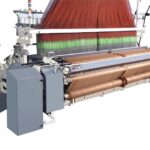What Is a Power Loom Machine? A Beginner’s Guide for Textile Entrepreneurs
Guide to Power Loom Machines for Textile Startups

In today’s competitive textile industry, efficiency and quality decides who leads the market and who lags behind. For many textile entrepreneurs, the power loom machine has become a game changing tool. The power loom machine is a key element in the development of the textile industry. It has transformed fabric production by replacing manual weaving methods. This shift led to a mass production and economic growth. In India the power loom industry is vital, by providing many jobs and boosting exports. It is important for businesses looking to invest in this critical equipment to understand its component. But what exactly is a power loom machine, and why should it matter to your business? Let’s break it down in simple terms and explore how it can give your textile venture the edge it needs.
What is a Power Loom?
A power loom is an automated weaving device that uses mechanical power to interlace threads into any fabric. Unlike the traditional practices that require manual labour, power looms operate using electricity or steam, which in turn increases the production and efficiency of the work. Earlier power looms were set up in large weaving sheds and powered by steam engines using belts and shafts. Today almost every power loom is running on electricity, making them quicker, cheaper and easy to operate. This innovation transformed the fabric industry from home scale models to big industries, paving the way for modern textile manufacturing.
Where are Power Loom Machines used?
Power loom machines are backbone of many textile segments including :
- Apparel manufacturing – Shirts, trousers, dresses & ethnic wear
- Home textiles – Bedsheets, curtains & upholstery (craft of covering furniture with padding, springs, webbing, and fabric or leather)
- Industrial Fabrics – Canvas, filter cloths, geotextiles
- Speciality Fabrics – Jacquard design, silk blends, decorative patterns
Types of Power Loom Machine
Shuttle looms
Traditional type of power loom that uses a shuttle to carry the weft thread back and forth
Best For – Basic Fabrics, small to medium scale promotion
Pros – Affordable, Easier to Maintain
Cons – Slower than modern alternatives
Shuttle less looms
Uses alternative methods ( rapier, air jet, water jet ) to insert weft without a shuttle.
Best For – High speed production & advanced fabrics
Pros – Faster, less wear on yarns
Cons – Higher cost, complex to operate
Jacquard Looms
A specialised loom that can create intricate patterns using punched cards or computer programming
Best For – decorative fabrics, sarees and patterned textiles
Pros – complex design made possible
Cons – Expensive, requires skilled operators
Advantages of Using a Power Loom Machine for Textile Entrepreneurs
- High Productivity. You can produce more fabric in less time, which allows you to take on bigger orders.
- Consistent Quality. Automated control reduces human error and ensures uniform weaving.
- Cost Efficiency. You will have lower labor costs per unit of output compared to handloom operations.
- Scalability. It is easy to expand production by adding more machines.
Factors to consider before investing in any Power Loom Machine
- Types of fabrics you wish to produce- Heavy fabrics, pattern design fabrics, fine fabrics, as each fabric may require specific loom machine types.
- Available Space & Infrastructure – Power loom machines need stable flooring, proper electrical setup and ventilation facility.
- Budget & Financing – Weigh upfront costs against potential product gains.
- Skilled Operators – While automated, power loom machines still require trained staff for setup, maintenance and troubleshooting.
Which Powerloom machine is best for Beginners ?
If you are new to the textile manufacturing industry, it is best to start with a conventional shuttle power machine. These machines are affordable, easy to operate and suitable for producing a large variety of basic fabrics. While they may not match the speed of the latest shuttle-less models, they are best for learning the weaving process, understanding fabric quality control, and building your first customer base. Once your operations grow and business expands you can shift to automatic or shuttle less power loom machines for higher productivity and specialised fabric production as and when required.
Business Tips for First Time Power Loom Owners
- Start small & eventually scale-up – Begin with 2-4 loom machines to control costs and learn the basics to advance your business.
- Choose right location – Ensure easy access to raw materials, skilled workers & markets
- Understand your market – Decide if you want to produce for apparel, home furnishings or industrial use.
- Focus on quality – Quality fabrics get repetitive orders, even if your production speed is modest.
- Plan for maintenance – Regular services reduce downtime and prevent costly breakdowns.
Final Thoughts
The power loom machine has turned out to be a revolution for the textile industry, turning fabric weaving into faster, more efficient and profitable access. For beginners understanding the types, benefits and business strategies around power loom usage can make the difference between a struggling start and a thriving textile enterprise.
By choosing the right machine, starting at a manageable scale and keeping a keen eye on market trends, you can setup textile business that not only meet demands but stands out for quality and innovation






